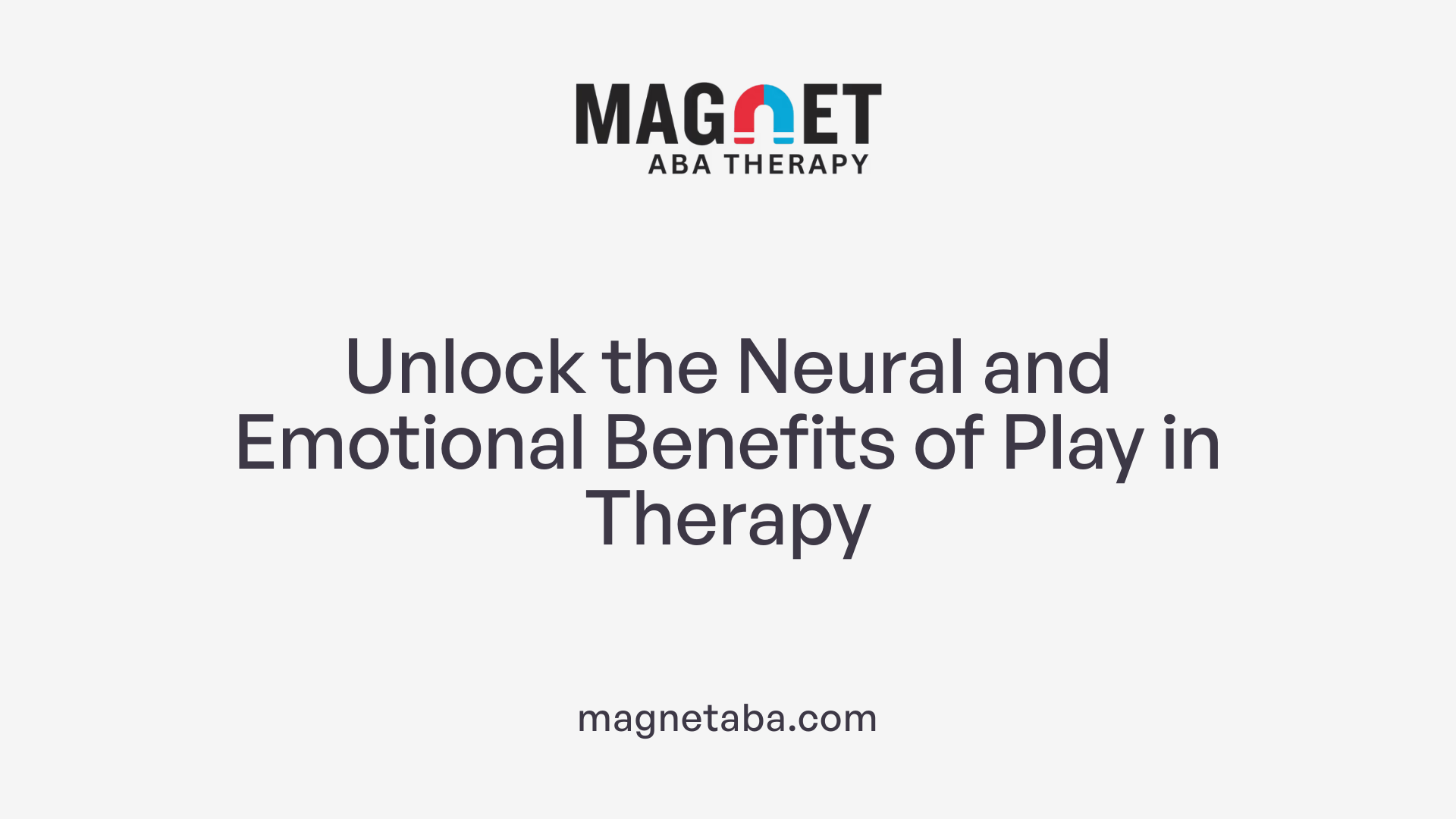The Power of Play in Shaping Development
Play is a cornerstone of early intervention ABA programs, serving as a natural, engaging way to foster numerous developmental skills in children with autism spectrum disorder (ASD). By integrating play into therapeutic practices, clinicians and parents create a positive, motivating environment that promotes growth across social, communication, cognitive, and emotional domains. This article explores the multifaceted role of play, its benefits, how it is incorporated into ABA therapy, and its profound impact on therapeutic outcomes for young children with ASD.
Understanding the Role of Play in Early Intervention ABA Programs

What is the role of play in early intervention ABA programs for children with autism?
Play is a central component of early intervention ABA programs designed for children with autism. It fosters development across various areas, including social skills, communication, cognition, and emotional regulation.
Through engaging activities like structured play and pretend play, children learn to express themselves comfortably and connect with others. These activities often include group interventions such as the Integrated Play Group and Floor Time models, which encourage interaction and social cognition.
Play-based approaches not only help children build positive behaviors but also promote neural development by supporting neuroplasticity—the brain's ability to reorganize itself by forming new neural connections. This process underpins learning, skill acquisition, and behavior change.
Involving both parents and therapists in play makes interventions more effective, creating a nurturing environment that promotes overall growth and independence. When play is incorporated into ABA, it transforms learning into an enjoyable experience, increasing engagement and motivation.
Why is play important for developmental progress and therapeutic outcomes in early childhood intervention?
Play actively engages children in exploring their environment, which is vital for their development. It supports the growth of cognitive, motor, social, emotional, and language skills.
During play, children learn essential concepts like cause and effect, problem-solving, and object permanence. These experiences contribute to healthy brain development by strengthening neural connections.
Play also offers a safe space for children to imagine adult roles, practice social interactions, and regulate emotions, all of which are crucial for social and emotional growth.
Structured and unstructured play activities encourage creativity, resilience, and flexibility—traits that benefit therapeutic progress. Skills developed through play are more likely to generalize to real-life situations, helping children adapt better across different contexts.
In summary, play is a fundamental method in early childhood intervention, fostering comprehensive developmental growth that directly influences therapeutic success.
How play facilitates engagement and motivation
Engagement and motivation are essential for effective therapy, especially for children with autism. Play naturally captures children’s attention, making learning enjoyable and interactive.
Using games matching a child's developmental level and interests boosts their motivation to participate. Strategies such as modeling, positive reinforcement, and visual supports like turn-taking visuals or First/Then charts help maintain focus and encourage task completion.
Breaking down complex activities into smaller, manageable steps decreases feelings of being overwhelmed. Reinforcers, including praise and preferred items, motivate children to keep engaging with play activities.
Consistent use of prompts and sticking to the play plan build confidence and establish routines, enhancing overall participation. These techniques leverage the child’s natural curiosity, increasing active involvement and accelerating skill acquisition.
How the influence of play on neural development and neuroplasticity enhances learning
Play is instrumental in shaping neural development, especially in early childhood. It stimulates various brain regions involved in learning, problem-solving, social understanding, and emotional regulation.
Activities incorporating planning, strategy, and problem-solving during play foster neural circuit formation, strengthening connections necessary for complex cognitive tasks.
Pretend play, in particular, promotes symbolic thinking and imagination, which are linked to higher-order brain functions. It encourages children to view the world from different perspectives, enhancing empathy and social understanding.
Research indicates that active, enriched interactions through play increase neuroplasticity—the brain's ability to adapt and learn new skills. This adaptability is crucial for children with autism, who often experience challenges in neural connectivity.
In summary, play not only supports immediate skill development but also causes lasting changes in brain architecture, laying a foundation for lifelong learning and adaptability.
| Aspect | Impact | Additional Details |
|---|---|---|
| Social Skills | Improved peer interactions | Encourages cooperation, imitation, and negotiation |
| Communication | Increased expressive and receptive skills | Facilitates language use through interactive play |
| Cognitive Development | Enhanced problem-solving and reasoning | Promotes planning and strategic thinking |
| Emotional Growth | Better emotion regulation | Supports understanding and managing feelings |
| Neural Development | Strengthening of neural circuits | Boosts neuroplasticity through engaging activities |
| Motivation & Engagement | Higher participation rates | Achieved by matching interests and using reinforcement |
Focusing on play as a therapeutic tool in autism intervention taps into children’s natural tendencies, making therapy more enjoyable and effective, fostering a holistic developmental trajectory.
Integrating Play Skills into ABA Therapy for Children with Autism

How are play skills integrated into ABA therapy for children with autism spectrum disorder?
Play plays a vital role in ABA therapy, serving as a natural and engaging platform for promoting social, communication, and cognitive skills. Therapists use developmentally appropriate activities such as role-playing, pretend play, and social narratives to help children understand social cues, encourage reciprocal interactions, and practice appropriate behaviors in enjoyable contexts.
Incorporating sensory activities, puzzles, singing, and story reading within therapy sessions fosters motivation and sensory integration, which are essential for language development and emotional regulation. These activities are designed to be fun and meaningful, ensuring children are motivated to participate actively.
Furthermore, the use of peer modeling and visual supports helps children generalize their play and social skills in natural environments. Structured social activities and play-based interventions are backed by research and support holistic growth, including independence, emotional regulation, and social competence.
Overall, integrating play into ABA therapy allows children to learn skills in a context that feels natural and engaging, making the development process more effective and meaningful.
The Benefits of Play for Neural and Behavioral Development

What are the benefits of using play within ABA therapy during early intervention?
Incorporating play into ABA therapy during early intervention offers numerous advantages for children with autism. Play-based activities are inherently child-centered and natural, making learning engaging and enjoyable. This approach leverages children's innate interest in play to facilitate motivation, which leads to more effective skill acquisition across various domains such as communication, social behavior, and cognition.
Through play, children have safe, flexible opportunities to practice social interactions like turn-taking, sharing, and imitation. These interactions help build foundational social skills and foster emotional expression and regulation. Play also provides a context for activities like role-playing and storytelling, supporting the development of empathy and understanding of social cues.
Moreover, using play enhances neural development by promoting brain plasticity. Engaging in playful activities stimulates the formation of new neural pathways, which support learning and behavior improvements. This is especially important in early intervention, as it lays the groundwork for long-term developmental gains.
Overall, the integration of play into ABA therapy creates a positive, motivating, and adaptable environment that not only encourages skill growth but also nurtures emotional health and resilience. It makes therapy sessions more engaging and meaningful, ultimately leading to better generalization of skills to real-life situations.
How does play contribute to neural development and social skill acquisition?
Play plays a vital role in shaping neural development and fostering social skills. It encourages neural plasticity by stimulating the brain through various activities that challenge cognitive and social processes. During play, children develop new neural circuits that support complex behaviors, problem-solving, and strategic thinking.
Activities such as pretend play or role-playing enable children to practice social behaviors, including cooperation, negotiation, and empathy. These activities help children understand social norms, recognize social cues, and respond appropriately. Repeated engagement in social play enhances children’s ability to form peer relationships and improves social cognition.
Furthermore, play activities involve multiple skills—such as turn-taking, sharing, and responding to others’ cues—that are fundamental for social interaction. As children navigate these interactions, their emotional regulation improves, and they learn to cope with frustration or disappointment more effectively.
Research shows that structured, engaging play experiences lead to improved adaptability and resilience. These experiences not only support immediate social and behavioral development but also contribute to long-term neural growth and cognitive flexibility.
Engaging in play helps children with autism acquire social skills in a motivating and natural way, laying the foundation for meaningful social interactions and emotional wellbeing.
What role does focused, structured play have in early intervention programs?
Structured play is essential in early intervention programs because it combines the engaging nature of play with goal-oriented learning. Unlike unstructured play, structured play involves specific activities designed to teach particular skills or behaviors, often supported by visual aids and reinforcement strategies.
Visual supports like turn-taking visuals or First/Then charts help children understand the expectations of each activity, reducing anxiety and increasing participation. Prompts, modeling, and chaining provide clear guidance, helping children learn behaviors step-by-step.
Reinforcement—such as verbal praise or preferred items—encourages children to complete targeted play tasks and promotes skill retention. When play activities are broken into manageable steps, children are less overwhelmed and can experience a sense of achievement.
Implementing structured play in familiar environments, like in California-based therapy settings, minimizes anxiety and creates a stress-free zone conducive to learning. This approach allows therapists to tailor interventions based on each child's unique interests and needs, making therapy more effective and engaging.
Ultimately, structured play not only teaches specific skills but also builds confidence, promotes socialization, and encourages generalization of new behaviors to everyday situations.
How do strategies like modeling, reinforcement, and visual supports improve play-based therapies?
Strategies such as modeling, reinforcement, and visual supports are integral to optimizing play-based therapies. Modeling demonstrates desired behaviors, showing children how to engage appropriately in play activities, which helps develop imitation and social skills.
Reinforcement—whether verbal praise or preferred items—motivates children to participate actively and complete tasks. Consistent reinforcement helps establish clear connections between behavior and positive outcomes, increasing the likelihood of skill generalization.
Visual supports provide clear, concrete cues about turn-taking, activity expectations, or sequences using visuals like charts or pictures. These tools help children understand the structure of play, reduce frustration, and promote independence.
Chaining and scripting further support learning by breaking activities into smaller steps and guiding interactions, supporting skill mastery and transfer to natural settings.
Together, these strategies foster a positive, engaging environment for children, encouraging active participation and effective learning during therapy sessions. Consistency and tailored use of prompts enhance progress and support meaningful development.
How can we assess motivation for play and modify activities accordingly?
Assessing motivation for play involves observing children's requests, initiations, responses to partners, and overall affect. Noticing how children respond to different activities helps therapists identify what interests and motivates each child.
If a child shows high interest or enjoyment, it indicates strong motivation, which can be harnessed to enhance learning. Conversely, identifying less engaging activities allows therapists to modify or replace them.
Modifications include incorporating the child's interests into the game, using preferred items as reinforcement, or adjusting the complexity of activities to match the child's developmental level.
Visual aids, like activity visuals or First/Then charts, can also increase motivation by providing clarity and predictability.
Monitoring observable measures of enjoyment—such as laughter, eye contact, or enthusiastic responses—helps track progress and inform adjustments.
By tailoring activities to each child's preferences and responses, therapists can boost engagement, promote skill acquisition, and encourage the generalization of play skills beyond therapy sessions.
How does structured, play-based ABA therapy influence communication, socialization, and behavior management?
Structured, play-based ABA therapy integrates evidence-based techniques into engaging activities that directly target communication, social skills, and behavior management. By focusing on play, children learn to communicate their needs, desires, and feelings through natural interactions.
The approach encourages socialization by creating opportunities for children to practice taking turns, sharing, and cooperating—essential skills for forming friendships and peer interactions. Activities like games and role-playing foster empathy and understanding of social cues.
Behavior management is reinforced through positive strategies such as modeling, prompting, and reinforcement within fun, motivating play settings. These techniques help reduce maladaptive behaviors and replace them with functional alternatives.
With consistent practice, children develop improved adaptive behaviors, better self-regulation, and more effective communication skills. This comprehensive approach fosters long-term developmental progress and prepares children for success in everyday social environments.
| Aspect | Focus Area | Supporting Strategies | Expected Outcomes |
|---|---|---|---|
| Communication | Enhancing expressive and receptive skills | Modeling, scripting, visual aids | Improved verbal and non-verbal communication skills |
| Social Interaction | Building peer and adult relationships | Turn-taking, role-playing, reinforcement | Increased social engagement and relationship formation |
| Behavior Management | Reducing maladaptive behaviors | Prompting, shaping, reinforcement | Better self-control and adaptive behavior patterns |
Supporting Play and Development Through Structured Strategies
How can play be used therapeutically to facilitate learning and skill development in young children with ASD?
Play serves as a natural and motivating context for children with Autism Spectrum Disorder (ASD) to develop essential skills. Therapeutically, play allows children to practice communication, social interactions, and emotional regulation in ways that feel enjoyable and meaningful to them. Various approaches such as child-centered, sensory, and art-based play therapy help children learn to express themselves and engage with others.
Engaging in play promotes brain development, neuroplasticity, and integration of neural functions. These improvements support cognitive growth and better behavioral responses. Play therapy can also help reduce problematic behaviors by guiding children toward more appropriate ways to express their feelings and manage emotions. Customizing play activities to meet each child's unique needs and constantly assessing progress enhances the effectiveness of therapy. Ultimately, play-based interventions can lead to improved daily functioning and overall development, paving the way for greater independence and social success.
What methods support structured and effective play therapy sessions?
Supporting effective play therapy involves a combination of visual supports, reinforcement, and careful activity management. Visual aids such as turn-taking visuals, activity visuals, and First/Then boards help children understand what to expect and what steps to follow during play.
Reinforcement strategies, including verbal praise and access to preferred items, motivate children to participate and complete activities. Breaking activities into smaller, manageable parts can lessen feelings of overwhelm and encourage success. Maintaining consistency in the play plan and using prompts when needed ensure that children stay engaged and follow through with activities. It’s also important to avoid unpreferred activities unless they are part of a reinforcement plan.
Collaboration between therapists and parents allows for personalized interventions that are consistent across different settings. These strategies create a predictable environment that boosts confidence and fosters meaningful learning experiences.
Use of visual supports, reinforcement, and step-by-step guidance
Incorporating visual supports such as turn-taking visuals, activity visuals, and First/Then visuals helps structure play activities and clarify expectations. Reinforcers like verbal praise, stickers, or preferred toys increase motivation, making children more likely to engage actively.
Breaking down complex tasks into small steps and providing visual cues helps children grasp each part of the activity, reducing frustration. Additionally, employing prompts and strategies like chaining or scripting can guide children through play sequences effectively.
Significance of consistency and individualization in interventions
Consistency in following the structured play plan is crucial for building trust and familiarity, which encourages children to participate willingly. Tailoring activities to each child's developmental level and interests makes play more engaging and relevant, leading to better skill acquisition and generalization.
This individualization ensures that learning is relevant and motivating, which supports sustained engagement and progress.
Role of therapist and parent collaboration
Close collaboration between therapists and parents ensures consistency and reinforces strategies across environments. Parents can learn techniques like visual supports and reinforcement methods to continue interventions at home. This teamwork enhances the child's learning experience, maintains motivation, and accelerates progress.
Together, they can adjust interventions based on ongoing observations, ensuring that play remains a positive and effective means of development.
| Strategy | Purpose | Implementation Details |
|---|---|---|
| Visual Supports | Clarify expectations | Turn-taking visuals, activity visuals, First/Then visuals |
| Reinforcement | Boost motivation and engagement | Verbal praise, preferred items, token systems |
| Activity Breakdown | Reduce overwhelm, encourage participation | Smaller steps, clear visuals, prompts |
| Consistency & Individualization | Foster trust and cater to each child's needs | Tailored activities, routine adherence |
| Therapist-Parent Collaboration | Ensure strategies are used consistently at home | Training, shared planning, regular communication |
Supporting children with autism through structured play strategies offers a comprehensive approach. Visual aids, reinforcement, and step-by-step guidance create a predictable and engaging environment. When these techniques are personalized and implemented consistently by both therapists and parents, children are more likely to succeed and develop essential skills in a positive, stress-free manner.
Fostering Growth: The Enduring Impact of Play in Autism Interventions
Incorporating play into early intervention ABA programs is not merely an engaging technique but a strategic approach that profoundly influences a child's developmental trajectory. Play stimulates neural development, enhances social and communication skills, and fosters emotional resilience. When thoughtfully integrated using structured strategies, visual supports, and personalized interventions, play becomes a powerful tool to support meaningful learning, facilitate generalization of skills, and promote independence. As research continues to underscore the benefits of play, practitioners and families are empowered to harness this natural activity to create nurturing environments where children with autism can thrive and reach their full potential.
References
- The Importance of Play in Early Childhood Interventions
- ABA Therapy: Structured, Play-Based Programs
- Teaching Game Playing to Children With Autism
- Play Plans in Applied Behavior Analysis (ABA)
- Play therapy in children with autism: Its role, implications ...
- The Role of Play in ABA Therapy: Making Therapy Fun
- An Examination Of Play Intervention Strategies for Children ...
- Scoping Review on Play-Based Interventions in Autism ...












